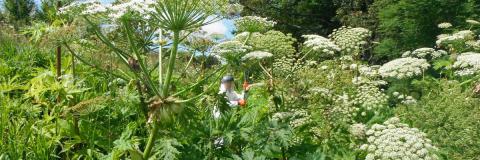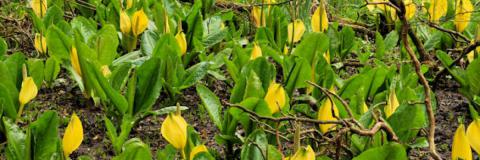Meet the plant
Japanese knotweed (Fallopia japonica) has a bamboo like stem, with purple speckles and roughly triangular green leaves between 10-15cm long, on a zig-zag twig. It has an extensive root system of rhizomes, making it difficult to remove. Roots can grow up to 3m deep, and travel up to 7m laterally in all directions.
It was introduced from the far East to Europe in 1849, first being recorded in the wild in GB in South Wales in 1886. Japanese knotweed was considered an ornamental "architectural" plant and widely grown in larger gardens and parks. It was also thought to have been planted by local governments and businesses to shore up embankments and pathways, as it was believed to protect the ground from mudslides and movement.
It tends to grow on disturbed ground, on riverbanks, railways, road sides, waste land and in urban areas. Occasionally it may be found in woodland.
Download the Japanese knotweed ID guide
Read more about Japanese knotweed

Impacts
Japanese knotweed forms dense stands which stops native flowers and shrubs from growing. However, the actual impact of this is poorly researched as it usually grows on sites that are already degraded and bare of other plants.
It does alter the habitat structure and wildlife of a river bank, which is known to directly impact on salmonid fisheries, both due to restricting access for angling and hindering conservation efforts of rivers.
The rhizomes of the plant are extremely tough and re-grow readily. It has caused problems by growing through foundations of houses and pavements and this has led to the plant having a high economic impact. It is a legal requirement to eradicate Japanese knotweed from construction sites, to do so is very costly, in the actual removal and the disposal of what is classed as contaminated waste.

Management of Japanese knotweed
Japanese knotweed grows in dense strands along many of the rivers in our project area. The root system of rhizomes in the riverbank can be left exposed as erosion and flooding wear away the soil allowing fragments of rhizome to be washed downstream and establish elsewhere. However, most plants in GB are sterile and do not produce viable seed after flowering. Therefore, it is not a particularly mobile species (IF the plant is not being cut or strimmed - which causes further spread!) and we are mostly dealing with long-established mature Japanese knotweed stands in our control programme.
In most of our control work we apply approved herbicide to the plants via knapsack sprayer or stem injection - on average, we inject nearly 50,000 individual stems per year. These methods, particularly stem injection, allow us to target chemical application to the Japanese knotweed and avoid contact with other plant species. This work is undertaken by qualified staff and volunteers.
This work is only been possible thanks to the support and work of numerous volunteers who have come along and helped. With stem injection in particular it is definitely a case of many hands make light work!
Site Case Study
Japanese knotweed control at Dunkeld Bridge, River Tay
Our Site Case Studies provide details of the control works undertaken at a particular site over a period of around three years and the results seen during that time.
You can read about the effectiveness (or not!) of the treatment regime on the abundance of invasive plants at the site and our future recommendations for continued control.
Japanese knotweed control
Herbicide Application
Due to its persistent rhizomes and ability to regenerate, research suggests the most effective way of controlling knotweed at scale and in the wider environment is by herbicide (Glyphosate) application. Treatment is needed over multiple years. While initial success and progress can be achieved and made in the first year, at least some of the root will remain and will grow to form a new stem if the treatment is not followed up in years 2-3. The average time for a chemical treatment programme is 3-5 years. Even after that time sites require to be monitored as rhizomes can remain dormant for a number of years before becoming active again – for example if the ground is disturbed.
Stem injection
We commonly use stem injectors (similar to a water pistol!) to apply herbicide. These deliver a measured dose of Glyphosate directly into the stem of the plant so is very targeted and effective, but can be quite slow work and rather labour intensive – particularly in larger stands.
Spraying
In large infestations we also apply herbicide using backpack sprayers. This is an effective means of treating larger areas initially to reduce the extent of growth. This approach can allow us to move towards stem injection chemical application when the problem has been diminished by year 1 sprayer application. We use specific nozzles to target and apply herbicide only to the target plants and foliage.
We treat plants from the late summer to autumn, usually between August and October. It is possible to treat the plant earlier in the season but late summer application is more effective as, at this time, the plant is diverting energy resources to the rhizome to support growth the following year. Therefore, herbicide applied at this time more effectively reaches the root systems and better reduces the growth of the plant.
Other treatment methods
None!
DO NOT cut, mow or strim growing Japanese knotweed. This will not kill the plant, re-growth from the root will follow and there is a high risk of making the problem worse as small fragments of root or stem with growth nodes are likely to be distributed and establish elsewhere.
Excavation requires the removal of all the rhizome and all the surrounding soil which is classed as contaminated. This is then classed as controlled waste and a licence is required for disposal. As such excavation is normally only carried out at a commercial development sites, often with the deployment of membrane barriers to prevent regrowth from any remaining rhizome fragments in the soil.
Digging of very small areas of the plant is possible e.g. in a garden location, but care must be taken to dispose of rhizomes to ensure regrowth does not take place off site.

Winter works
We have found it useful on some sites to visit in the winter and strim or cut back the dead canes of knotweed. This allows us easier access the next season carry out stem injection.
N.B. This is only carried out on dead, previously treated canes - never strim growing Japanese knotweed!
Useful links
- GB NNSS website - Japanese knotweed species information
- GB NNSS website - Japanese knotweed identification guide
- GB NNSS website - Japanese knotweed management and control methods



